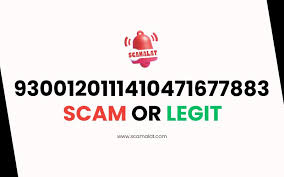9300120111410471677883 In today’s digital world, online scams have become more sophisticated and harder to spot. One such scam is the 9300120111410471677883 USPS scam, which targets unsuspecting individuals by posing as legitimate package delivery notifications. This scam aims to trick people into providing personal and financial information under the guise of resolving a delivery issue. Understanding how this scam operates and recognizing its signs can help you avoid becoming a victim.
Scammers are increasingly creative, employing various tactics to deceive individuals. By pretending to be from trusted institutions like the USPS, they exploit people’s trust and urgency to resolve what appears to be a minor issue. However, falling for such scams can lead to severe consequences, including identity theft and financial loss. Stay informed and vigilant to protect yourself and your personal information from these deceptive tactics.
Table of Contents
What is the 9300120111410471677883 USPS Scam?
The 9300120111410471677883 USPS scam is a fraudulent scheme where scammers impersonate the United States Postal Service (USPS) to steal personal information. They send fake notifications, often via email or text, claiming there’s a problem with a package delivery due to an incomplete address. The message includes the fake tracking number 9300120111410471677883 to lend credibility to the claim.
These scammers aim to create a sense of urgency, urging recipients to click a link or provide sensitive information to resolve the issue quickly. However, these links lead to phishing sites designed to capture personal data, such as names, addresses, phone numbers, and even financial information. Once obtained, this information can be used for identity theft, unauthorized financial transactions, or sold to other criminals on the dark web.
To protect yourself, it’s crucial to verify the legitimacy of any unexpected delivery notifications. Always check tracking numbers directly on the official USPS website and be cautious of links or attachments from unknown sources.
How Does the 9300120111410471677883 Scam Work?
The 9300120111410471677883 USPS scam employs several deceptive tactics to trick individuals into revealing their personal information. The scam typically begins with an unsolicited text message or email, claiming that a package cannot be delivered due to incomplete address details. This message includes a fake tracking number, 9300120111410471677883, which adds a layer of legitimacy to the claim.
Scammers create websites that mimic the official USPS site to convince recipients that they need to update their address or provide additional information to schedule a redelivery. These websites are often very convincing, using USPS logos and similar design elements to fool even the cautious. Once victims enter their information, it is captured by the scammers, who can then use it for identity theft or sell it on the dark web (Shoppersvila) (Malware Guide).
Scammers often employ a sense of urgency, warning that the package will be returned to the sender if no action is taken immediately. This pressure can lead victims to act without fully considering the legitimacy of the request, making it essential to recognize the red flags associated with these scams (Malware Updates).
Identifying the Red Flags of the 9300120111410471677883 Scam
Identifying the warning signs of the 9300120111410471677883 USPS scam can help prevent falling victim to this deceptive tactic. Here are some common red flags to look out for:
- Generic Greetings: Legitimate USPS communications will typically address you by name, while scam messages often use generic greetings like “Dear Customer.”
- Sense of Urgency: Scammers create a false sense of urgency, claiming that immediate action is needed to avoid negative consequences, such as returning the package to the sender.
- Suspicious Links: Be wary of links that do not direct you to the official USPS website. Scammers often use URLs that resemble USPS but have subtle differences.
- Strange Sender Addresses: Emails and texts from non-official addresses, especially those not ending in @usps.gov, are likely fraudulent.
- Requests for Personal Information: The USPS will never ask for sensitive personal information, such as your Social Security number or financial details, via email or text.
By staying alert to these warning signs, you can protect yourself from falling victim to the 9300120111410471677883 scam and similar fraud attempts.
What to Do If You Fall Victim to the 9300120111410471677883 Scam
If you have inadvertently shared personal information with scammers, it is crucial to act quickly to mitigate the potential damage. Here are steps you should take immediately:
- Contact Financial Institutions: Notify your bank and credit card companies about the potential fraud so they can monitor your accounts for suspicious activity. They may recommend freezing your accounts or issuing new cards.
- Place Fraud Alerts: Contact one of the three major credit bureaus (Experian, Equifax, or TransUnion) to place a fraud alert on your credit file. This makes it harder for scammers to open new accounts in your name.
- Monitor Credit Reports: Regularly check your credit reports for any unusual activity. You are entitled to a free credit report from each bureau once a year, which you can access at AnnualCreditReport.com.
- Change Online Passwords: If you used the same password on the fake USPS site as other accounts, change it immediately. Ensure your new passwords are strong and unique for each account.
- File Reports: Report the scam to the Federal Trade Commission (FTC) at IdentityTheft.gov and your local police department. Provide as much detail as possible to assist in their investigation.
- Watch for Additional Scams: Scammers often target previous victims again. Be cautious of any further emails, calls, or texts requesting personal information.
- Consider Credit Freezes: For maximum protection, consider placing a credit freeze with the three major credit bureaus, which prevents new accounts from being opened in your name.
By taking these steps promptly, you can minimize the impact of falling victim to the 9300120111410471677883 scam and protect your personal information from future threats.
How to Protect Yourself from Future Scams
Protecting yourself from future scams involves staying informed and adopting best practices for online security. Here are some tips to safeguard your personal information:
- Verify Communication Sources: Always verify the sender’s identity before responding to emails or texts. Check the sender’s email address and ensure it matches official USPS domains.
- Be Cautious with Links and Attachments: Avoid clicking on links or downloading attachments from unknown or suspicious sources. Instead, manually enter the website address in your browser to ensure its legitimacy.
- Use Strong, Unique Passwords: Create strong, unique passwords for each online account. Consider using a password manager to help manage and store passwords securely.
- Enable Two-Factor Authentication: Wherever possible, enable two-factor authentication on your accounts for an extra layer of security.
- Stay Informed About Scams: Keep up-to-date with the latest scams by subscribing to alerts from organizations like the Federal Trade Commission (FTC) or the Better Business Bureau (BBB).
- Educate Yourself and Others: Share information about scams with friends and family to help them recognize and avoid potential threats.
By following these tips, you can significantly reduce your risk of falling victim to scams and protect your personal information from cybercriminals.
Frequently Asked Questions About the 9300120111410471677883 USPS Scam
What is the 9300120111410471677883 USPS scam? The 9300120111410471677883 USPS scam is a phishing scam that uses a fake tracking number to trick individuals into providing personal information by posing as the USPS.
How does the scam work? Scammers send fake notifications claiming a package delivery issue, urging recipients to click a link or provide information to resolve it. These links lead to phishing sites that capture personal data (Shoppersvila) (Malware Guide).
What information do scammers want? Scammers aim to collect personal information, including names, addresses, phone numbers, and financial details, to commit identity theft or sell on the dark web.
How can I verify a USPS notification? Always verify USPS notifications by checking tracking numbers directly on the official USPS website. Be cautious of any links or attachments from unknown sources.
What should I do if I shared personal information? If you shared personal information, contact your bank and credit card companies immediately, place fraud alerts with credit bureaus, and report the scam to the FTC and local authorities (Shoppersvila) (Malware Updates).
Conclusion
The 9300120111410471677883 USPS scam is a reminder of the importance of vigilance and caution in today’s digital world. By understanding how this scam operates and recognizing the warning signs, you can protect yourself from falling victim to phishing attempts. Always verify the legitimacy of unexpected notifications, avoid clicking on suspicious links, and stay informed about the latest scams.
Read More: Blog ArcyArt








